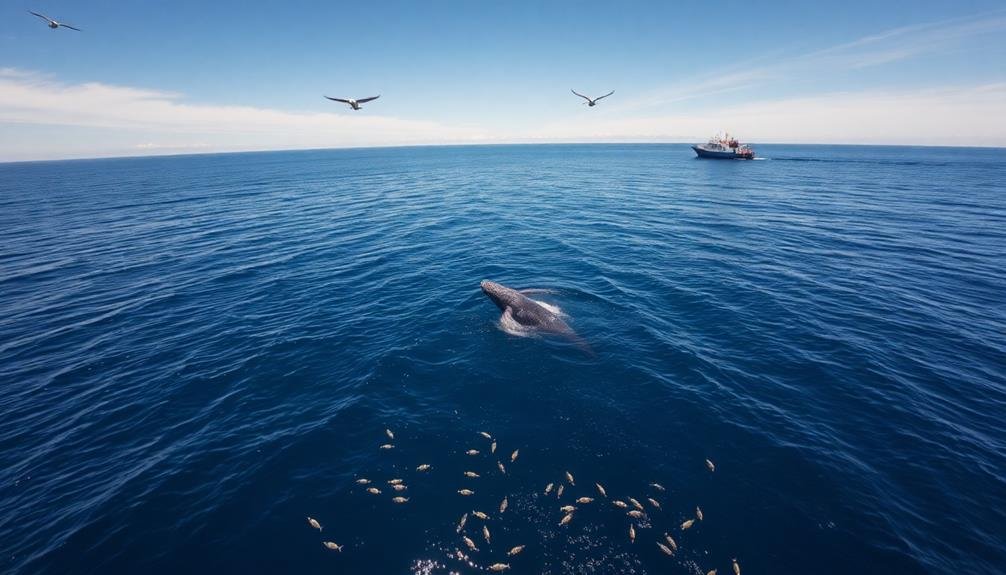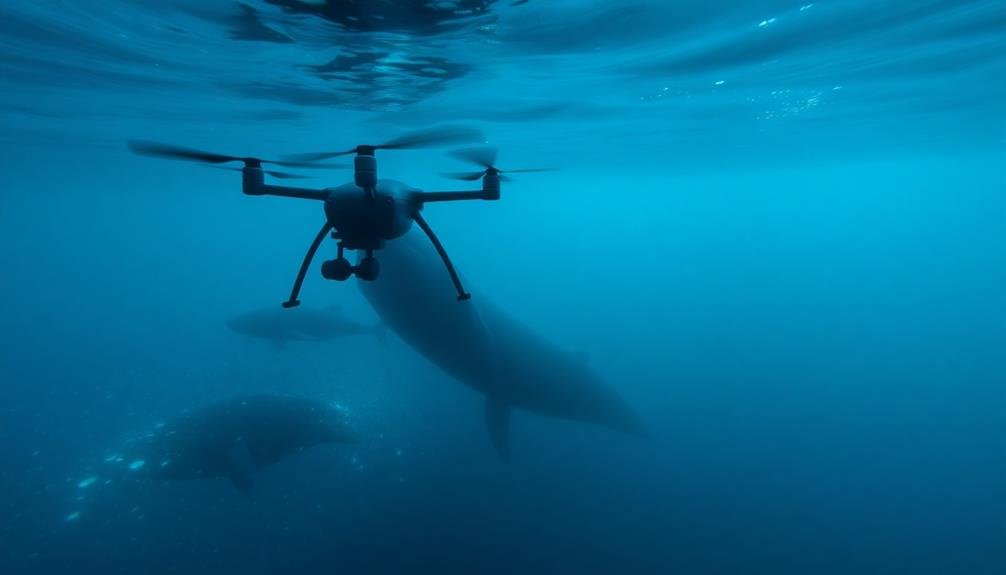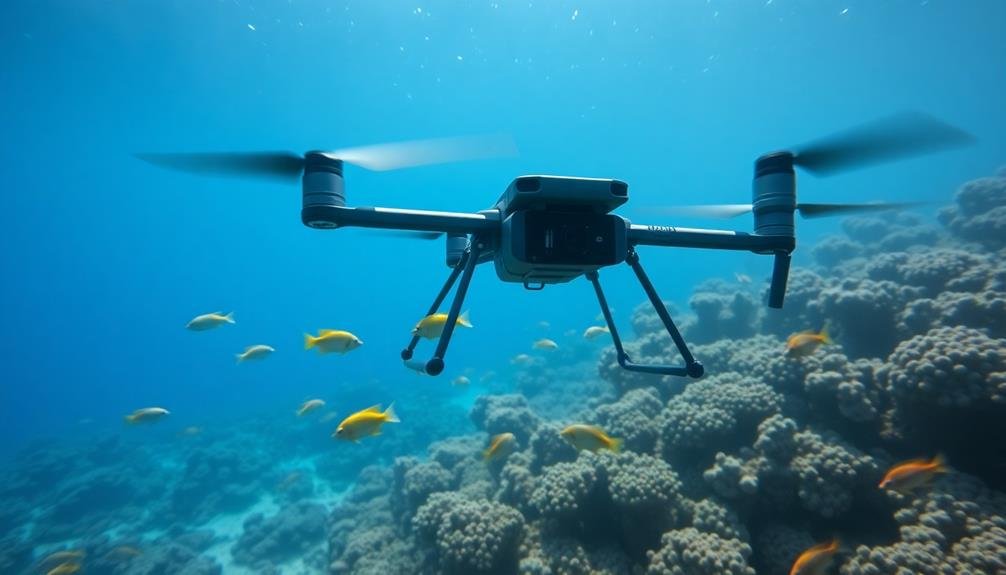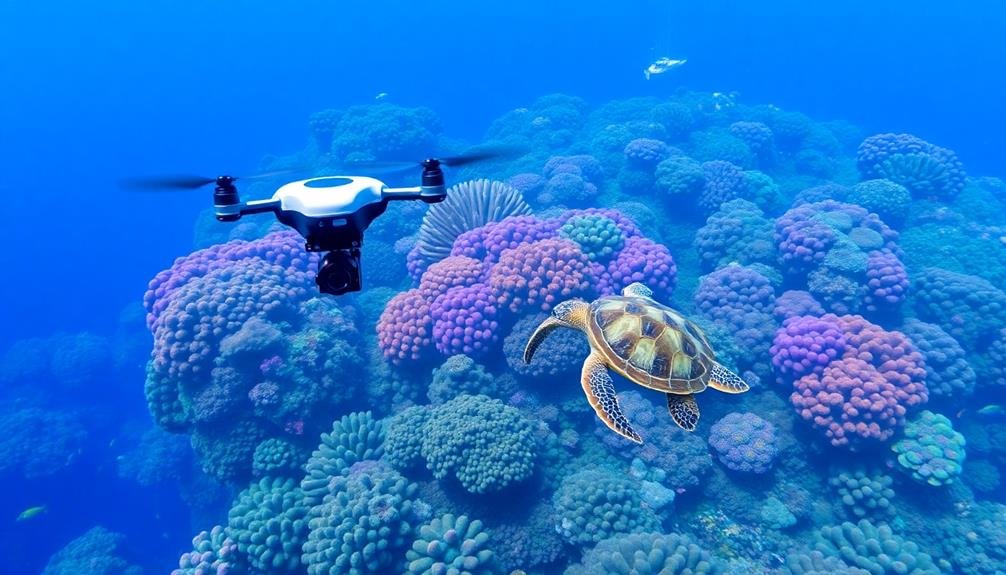Unmanned technology has revolutionized ocean wildlife studies in five key ways. You'll find aerial surveys using UAVs provide a bird's-eye view of marine populations without disturbance. Remote tracking with AUVs and USVs maps migratory patterns across vast distances. Underwater drones enable detailed habitat mapping and 3D modeling of ecosystems. Non-invasive behavioral studies are now possible, capturing natural behaviors without human presence. Finally, pollution monitoring in ocean ecosystems has improved with real-time data collection from advanced sensors. These innovations offer unprecedented access to marine environments, transforming how researchers study and protect ocean wildlife. Discover how these cutting-edge technologies are reshaping marine conservation efforts.
Aerial Surveys of Marine Populations

Aerial surveys have revolutionized the way scientists study marine populations. You'll find that unmanned aerial vehicles (UAVs) or drones are now essential tools for researchers tracking and monitoring sea life. These devices offer a bird's-eye view of vast ocean areas, allowing you to observe marine animals without disturbing their natural behaviors.
UAVs equipped with high-resolution cameras can capture detailed images and videos of whales, dolphins, and large fish schools. You'll be able to count individuals, assess population health, and monitor migration patterns with unprecedented accuracy. Thermal imaging cameras on drones even let you detect animals below the water's surface.
Compared to traditional boat-based surveys, aerial surveys using drones are more cost-effective and safer for researchers. You can cover larger areas in less time, reducing the need for extensive ship time. Drones also access shallow or dangerous waters that boats can't reach.
The data you collect from these aerial surveys helps inform conservation efforts, fishing regulations, and marine protected area management. It's a game-changer for understanding and protecting ocean ecosystems.
Tracking Migratory Patterns Remotely

With advances in unmanned technology, tracking migratory patterns of marine species has become more precise and less invasive.
You'll find that scientists now use autonomous underwater vehicles (AUVs) and unmanned surface vessels (USVs) to follow marine animals across vast ocean distances. These robotic devices can stay at sea for months, collecting data on animal movements, ocean conditions, and environmental factors.
You'll see that satellite tags and acoustic transmitters attached to marine animals send signals to these unmanned platforms, providing real-time location data. This allows researchers to map migration routes, identify important feeding and breeding grounds, and understand how climate change affects animal behavior.
Unmanned aerial vehicles (UAVs) also play an essential role in tracking migratory patterns. They can cover large areas quickly, capturing high-resolution imagery and thermal data to detect and monitor marine species from above.
You'll notice that this approach is particularly useful for studying surface-dwelling animals like whales and dolphins.
Underwater Drones for Habitat Mapping

Underwater drones have revolutionized habitat mapping in marine ecosystems. These autonomous vehicles allow you to explore and document underwater environments with unprecedented detail and efficiency.
You'll find that these drones can cover vast areas of the ocean floor, collecting high-resolution imagery and data that would be impossible to gather through traditional methods.
When you deploy underwater drones for habitat mapping, you're able to create detailed 3D models of coral reefs, seagrass beds, and other complex marine habitats. This technology enables you to monitor changes in these ecosystems over time, helping you track the impacts of climate change, pollution, and other human activities.
You'll appreciate how these drones can operate in areas that are too deep, dangerous, or remote for human divers. They're equipped with advanced sensors that measure water quality, temperature, and currents, providing an extensive view of the marine environment.
Non-Invasive Behavioral Studies

Non-invasive behavioral studies have taken off thanks to unmanned technology in marine research. You'll find that unmanned aerial vehicles (UAVs) and autonomous underwater vehicles (AUVs) are revolutionizing how scientists observe marine life without disturbing natural behaviors.
UAVs, or drones, allow you to capture high-resolution imagery and video of surface-dwelling species like whales, dolphins, and sea turtles. You can track migration patterns, monitor social interactions, and assess population health from a safe distance. These aerial platforms also enable you to study elusive species in remote or dangerous areas that were previously inaccessible.
Underwater, AUVs equipped with cameras and sensors let you observe deep-sea creatures in their natural habitats. You'll gather data on feeding behaviors, mating rituals, and predator-prey interactions without the disruptive presence of human divers.
These robots can stay submerged for extended periods, providing continuous monitoring of marine ecosystems. Both UAVs and AUVs can be outfitted with thermal imaging technology, allowing you to study nocturnal behaviors and track animals in low-visibility conditions.
This non-invasive approach minimizes stress on marine life while maximizing the quality and quantity of data collected.
Pollution Monitoring in Ocean Ecosystems

How can unmanned technology help combat ocean pollution? Autonomous underwater vehicles (AUVs) and drones are revolutionizing the way scientists monitor and assess pollution in ocean ecosystems. These unmanned devices can cover vast areas quickly, providing real-time data on water quality, microplastic concentrations, and chemical pollutants.
You'll find that AUVs equipped with advanced sensors can detect minute traces of pollutants, even in deep ocean environments. They're able to create detailed maps of pollution hotspots, helping researchers identify sources and track the spread of contaminants.
Aerial drones, on the other hand, can survey coastal areas and monitor oil spills, algal blooms, and marine debris from above.
These technologies allow for continuous monitoring without the need for constant human presence, reducing costs and increasing the frequency of data collection. They're also capable of accessing hazardous or remote areas that would be dangerous for human researchers.
Frequently Asked Questions
How Does Unmanned Technology Affect Marine Wildlife Stress Levels?
You'll find that unmanned tech reduces marine wildlife stress levels. It's less invasive than traditional methods, allowing for quieter, more distant observations. You won't disturb animals as much, leading to more natural behavior and accurate data.
What Are the Energy Sources for Long-Term Autonomous Ocean Exploration Devices?
You'll find that long-term autonomous ocean explorers often rely on solar power, wave energy, and thermal gradients. They'll also use fuel cells, lithium-ion batteries, and even nuclear power for extended missions. These sources guarantee continuous operation in harsh environments.
How Do Researchers Ensure Data Accuracy From Unmanned Devices in Harsh Environments?
You'll guarantee data accuracy from unmanned devices in harsh environments by using robust sensors, regular calibration, and redundant systems. You'll also implement data validation algorithms, conduct thorough testing, and compare results with other data sources when possible.
What Ethical Considerations Arise When Using Unmanned Technology for Wildlife Studies?
You'll face ethical concerns when using unmanned tech for wildlife studies. You must consider animal stress, habitat disruption, and data privacy. You're responsible for minimizing impact and ensuring responsible use of collected information.
How Does Unmanned Tech Integrate With Traditional Marine Biology Research Methods?
You'll find unmanned tech complements traditional methods by providing continuous data collection, accessing hard-to-reach areas, and reducing human disturbance. It enhances observation capabilities, improves safety, and allows for more thorough, long-term studies of marine ecosystems.
In Summary
You've seen how unmanned technology is transforming ocean wildlife research. From aerial surveys to underwater drones, these innovations allow scientists to study marine life like never before. You're witnessing a revolution in data collection, tracking, and monitoring. As you consider the future of marine conservation, remember that these tools are pushing the boundaries of what's possible. They're helping us understand and protect our oceans in ways we couldn't have imagined just a few years ago.

As educators and advocates for responsible drone use, we’re committed to sharing our knowledge and expertise with aspiring aerial photographers.




Leave a Reply